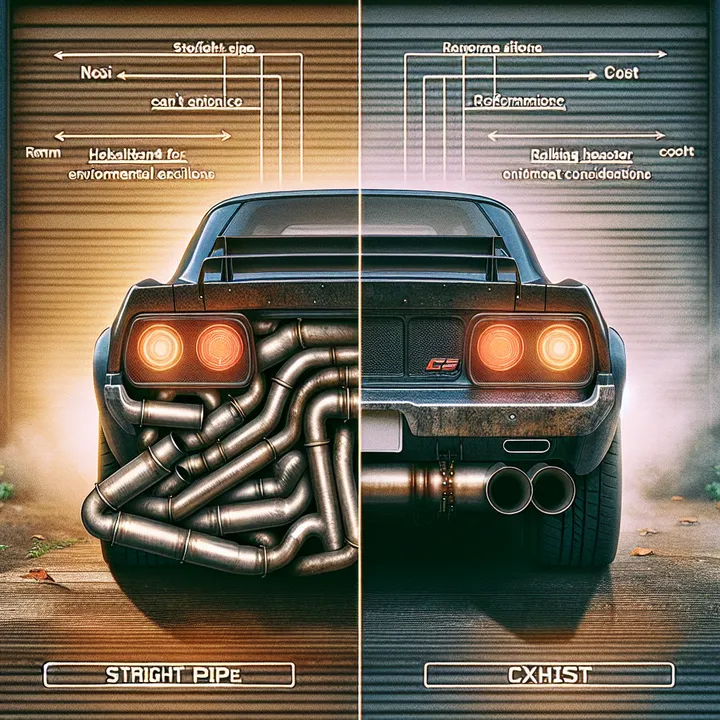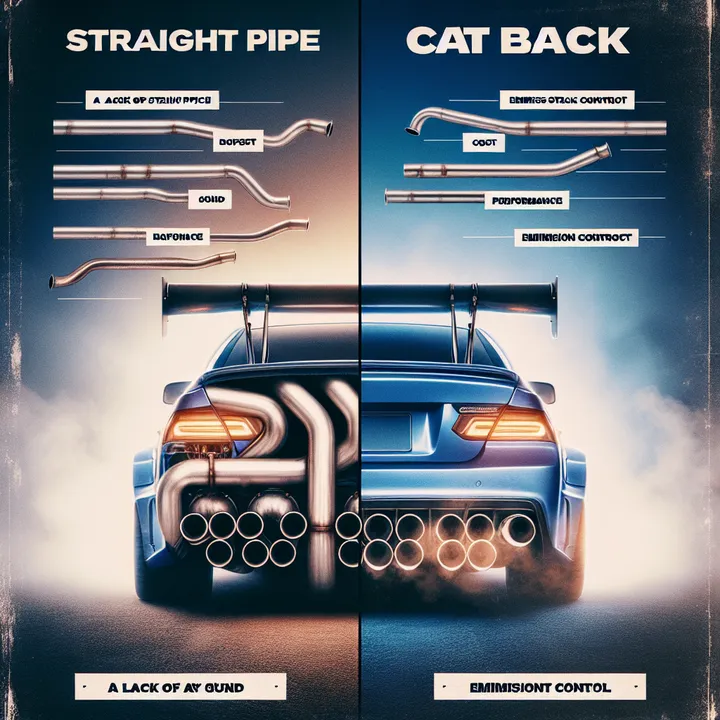


Automotive enthusiasts have long sought ways to enhance the performance and auditory experience of their vehicles. One of the most effective modifications lies in the exhaust system, a critical component that plays a pivotal role in engine efficiency, power output, and the distinctive sound that resonates from the tailpipe.

A straight pipe exhaust system is a relatively simple modification that involves removing the catalytic converter and muffler from the vehicle's exhaust system. By doing so, the exhaust gases can flow more freely, potentially increasing engine performance and producing a distinct, aggressive exhaust note.
For many car enthusiasts, the appeal of a straight pipe exhaust lies in its raw, unadulterated sound. The absence of a muffler allows the engine's roar to reverberate unfiltered, creating a visceral experience that some find exhilarating. Additionally, the reduced backpressure can potentially result in a slight increase in horsepower and torque.
| Straight Pipe Exhaust Pros | Straight Pipe Exhaust Cons |
|---|---|
| Aggressive exhaust note | Increased noise levels |
| Potential performance gains | Illegal for street use |
| Inexpensive modification | Increased emissions |
| Potential legal consequences |
However, it's crucial to understand that straight pipe exhaust systems are generally illegal for street use in most areas due to their impact on emissions. By removing the catalytic converter, which is designed to reduce harmful pollutants, straight pipes significantly increase the vehicle's emissions, contributing to air pollution and potentially violating local regulations.

Catalytic converters play a vital role in reducing harmful emissions, such as carbon monoxide, hydrocarbons, and nitrogen oxides.
Without a catalytic converter, these pollutants are released directly into the atmosphere, contributing to smog and air quality issues.
Many areas have strict emissions regulations and testing requirements, making straight pipe exhausts illegal for street-driven vehicles.
Moreover, the excessive noise levels produced by straight pipe exhausts can be a nuisance to others and may lead to citations or fines in residential areas or areas with strict noise ordinances.
In contrast to straight pipe exhausts, catback exhaust systems offer a more comprehensive and legal approach to enhancing exhaust flow and performance. These systems replace the components from the catalytic converter back, including the muffler, resonator, and tailpipes.
Catback exhaust systems are designed to reduce backpressure and improve exhaust flow, resulting in potential performance gains while retaining the catalytic converter for emissions control. These systems often feature larger-diameter piping, high-flow mufflers, and optimized exhaust tips, contributing to a deeper, more resonant exhaust note without the excessive noise levels associated with straight pipes.
| Catback Exhaust Pros | Catback Exhaust Cons |
|---|---|
| Legal for street use | More expensive |
| Improved performance | Professional installation recommended |
| Deeper exhaust note | |
| Retains emissions control |
Installing a catback exhaust system requires careful attention to detail and adherence to manufacturer instructions. Proper alignment, tight connections, and leak-free installation are crucial to ensure optimal performance and prevent potential issues such as exhaust leaks or rattling.
Follow the manufacturer's instructions precisely for proper installation.
Ensure all connections are tight and secure to prevent leaks.
Align the exhaust components correctly to avoid rattling or vibrations.
Consider professional installation for optimal results and longevity.
While catback exhausts are generally legal for street use, it's essential to research and comply with local regulations and emissions testing requirements, as some areas may have specific restrictions or guidelines.
When it comes to cost, straight pipe exhaust systems are typically more affordable, ranging from a few dollars for basic piping to a few hundred dollars for more elaborate setups. However, it's important to consider the potential legal consequences and fines associated with running an illegal exhaust system.
| Straight Pipe Exhaust Cost | Catback Exhaust Cost |
|---|---|
| $20 - $300 for basic piping | $250 - $1,000+ for systems |
| $200 - $500 for professional installation |
On the other hand, catback exhaust systems can be more expensive, with prices ranging from a few hundred dollars for entry-level options to over a thousand dollars for high-end, performance-oriented systems from reputable brands. Additionally, professional installation costs can add several hundred dollars to the overall expense.
In the ongoing debate between straight pipe and catback exhaust systems, there is no one-size-fits-all solution. While straight pipes offer an inexpensive way to achieve a distinct exhaust note and potential performance gains, their legal and environmental implications cannot be ignored. Catback exhausts, on the other hand, provide a more comprehensive and legal approach to enhancing exhaust flow while retaining emissions controls.
As a mechanic, my recommendation is to carefully weigh the pros and cons of each option, considering not only personal preferences but also legal requirements and environmental responsibilities. Ultimately, the choice should align with your driving needs, local regulations, and a commitment to responsible vehicle modifications.
Remember, the joy of driving should never come at the expense of disregarding laws or compromising the well-being of our shared environment. Embrace the thrill of performance enhancements while respecting the boundaries set forth by regulations and ethical considerations.
A straight pipe exhaust removes the catalytic converter and muffler, while a catback system replaces components from the catalytic converter back. Catbacks retain emissions controls while straight pipes increase emissions.
Yes, by reducing backpressure, straight pipes can provide a slight increase in horsepower and torque output. However, the gains are generally minimal.
No, straight pipe exhaust systems are generally illegal for street use in most areas due to increased emissions and excessive noise levels.
While not strictly required, professional installation of catback exhaust systems is highly recommended to ensure proper alignment, tight connections, and leak prevention.
Basic straight pipe exhaust setups can cost between $20 to $300, making them a relatively inexpensive modification.
Running an illegal straight pipe exhaust can result in citations, fines, or other legal consequences depending on local regulations and emissions testing requirements.
No, catback exhaust systems retain the catalytic converter, which helps control emissions within legal limits while improving exhaust flow.
While catback exhausts produce a deeper, more resonant exhaust note, they are designed to avoid excessive noise levels associated with straight pipes.
Catback exhaust system costs can range from $250 to over $1,000, plus an additional $200 to $500 for professional installation.
Key factors include personal preferences, local regulations, emissions requirements, noise ordinances, and a commitment to responsible vehicle modifications.

Sarah isn't your average gearhead. With a double major in Mechanical Engineering and Automotive Technology, she dived straight into the world of car repair. After 15 years of turning wrenches at dealerships and independent shops, Sarah joined MICDOT to share her expertise and passion for making cars run like new. Her in-depth knowledge and knack for explaining complex issues in simple terms make her a valuable asset to our team.











